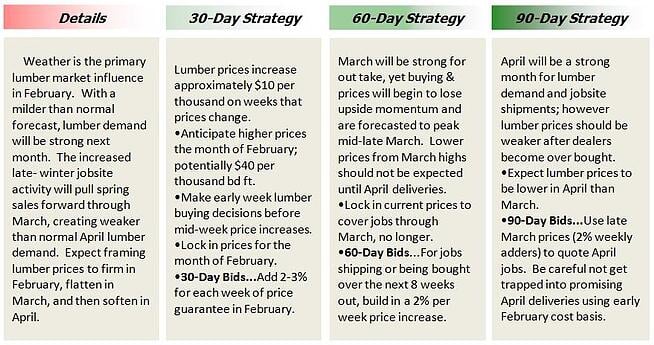Why Building a Backlog of Work Could Cost Some Contractors a Lot of Money
 Builders, remodelers and lumber dealers often get in trouble with lumber framing packages by overlooking the obvious…the volatile lumber market. Most contractors and lumber dealers do not have the luxury of pricing a job today, signing it tomorrow and buying the required materials the next day. By the time a job is priced, signed and the lumber gets delivered to the jobsite 30, 60 or even 90 or more days may have passed and lumber prices may have changed as much as 20%. At the Estimating Workshops I did this concern comes up quite often and attendees often share how their profits are affected as a result.
Builders, remodelers and lumber dealers often get in trouble with lumber framing packages by overlooking the obvious…the volatile lumber market. Most contractors and lumber dealers do not have the luxury of pricing a job today, signing it tomorrow and buying the required materials the next day. By the time a job is priced, signed and the lumber gets delivered to the jobsite 30, 60 or even 90 or more days may have passed and lumber prices may have changed as much as 20%. At the Estimating Workshops I did this concern comes up quite often and attendees often share how their profits are affected as a result.
An educated guess is much better than a Wild Ass Guess!
Matt Layman is the publisher of The Layman’s Lumber Guide. I met Matt through LinkedIn. His expertise is forecasting “when” lumber market pricing will change. Having and using the information he assembles through his research can help contractors and lumber dealers price future jobs involving framing materials with precision.
According to Matt lumber prices are reported twice weekly.
 He says some weeks do not change at all. However he also points out that 70% of the time they do change by an average 2.5% each week or 10% per month. Based on those realities a contractor who estimates a framing package using today’s lumber costs at $10,000 may end actually paying over $13,000 for that same package 90 days later. For those of you who understand how margins and markups work, not only will the contractor have lost the $3300 due to price increases, but also the gross profit margin on that difference. At a 50% markup that’s another $1650 of gross profit that could have been included in the sell price to help cover overhead and profit.
He says some weeks do not change at all. However he also points out that 70% of the time they do change by an average 2.5% each week or 10% per month. Based on those realities a contractor who estimates a framing package using today’s lumber costs at $10,000 may end actually paying over $13,000 for that same package 90 days later. For those of you who understand how margins and markups work, not only will the contractor have lost the $3300 due to price increases, but also the gross profit margin on that difference. At a 50% markup that’s another $1650 of gross profit that could have been included in the sell price to help cover overhead and profit.
If as a contractor you buy a lot of framing materials you may want to consider subscribing to Matt’s monthly publication called the Lumber Market Blueprint. I also think lumber dealers serving contractors could share this information with their customers on a regular basis. Doing so would be a great service that could help differentiate them in the marketplace.

The image above is an excerpt from the February issue of Matt’s Lumber Market Blueprint. Notice that the information not only includes his predictions for the next 30, 60 and 90 days, he also offers some insight as to why he makes his predictions. I suggest by knowing the why’s behind his predictions you can consider your own pricing adjustments if for any reason conditions change dramatically during the month.
I appreciate Matt allowing me to share this information with you.
If you are a contractor do any of your lumber dealers share this kind of info with you? If so, it would be great if you shared the name of the dealer with us as well as an example about how the information has helped you.



 It would appear that in the original interview ProSales had with Lowes about the story the fact that Lowes was selling 2x4’s that did not meet the standard accepted size of 1 ½” x 3 ½” was a detail left out of the interview. I say this with a high level of confidence because I find ProSales to be consistently accurate and the magazine editor, Craig Webb, does a great job vetting the information being published.
It would appear that in the original interview ProSales had with Lowes about the story the fact that Lowes was selling 2x4’s that did not meet the standard accepted size of 1 ½” x 3 ½” was a detail left out of the interview. I say this with a high level of confidence because I find ProSales to be consistently accurate and the magazine editor, Craig Webb, does a great job vetting the information being published.  The concern I am expressing is if these rules apply to retailers will they also apply to contractors? If they do, or eventually will, contractors in California and the rest of the country may also run into challenges not only with the government, but also with their customers. Perhaps trade associations such as NAHB and NARI should proactively seek out the answer to this question to help guide and protect their members and the rest of the construction industry. The RRP Rule came about because our industry didn’t proactively deal with the hazards of lead during construction on its own before the government stepped in and dictated regulations many do not agree with.
The concern I am expressing is if these rules apply to retailers will they also apply to contractors? If they do, or eventually will, contractors in California and the rest of the country may also run into challenges not only with the government, but also with their customers. Perhaps trade associations such as NAHB and NARI should proactively seek out the answer to this question to help guide and protect their members and the rest of the construction industry. The RRP Rule came about because our industry didn’t proactively deal with the hazards of lead during construction on its own before the government stepped in and dictated regulations many do not agree with. 
 One thing that remained fairly constant during this evolution was who the contractors were and how they did business. For decades the majority of contractors operated their businesses as technicians. They thought of themselves as contractors, not construction business owners. The joy of building things and advancing their trade skills where the driving factors that made them who they were. As a result of this mentality, and the fact that there was almost always way more work available than contractors to do it, they could command profitable prices. And unfortunately, at the same time, they could also get by with poor business practices in the areas of sales, marketing and accounting.
One thing that remained fairly constant during this evolution was who the contractors were and how they did business. For decades the majority of contractors operated their businesses as technicians. They thought of themselves as contractors, not construction business owners. The joy of building things and advancing their trade skills where the driving factors that made them who they were. As a result of this mentality, and the fact that there was almost always way more work available than contractors to do it, they could command profitable prices. And unfortunately, at the same time, they could also get by with poor business practices in the areas of sales, marketing and accounting. 

 Building product suppliers who have high debt may not be able to finance the cost of increasing their inventories to keep up with the predicted supply and demand challenges as the economy improves. If this happens at your supplier you may find that many products, even common commodities like framing lumber, will be out of stock. Imagine going to the lumberyard first thing in the morning to get the materials you need to frame a deck or reframe that kitchen, only to find out you can’t get what you need. To keep working that day you might have to pay for longer lengths than you need, or might even have to drive to a different supplier in the hopes that they will have what you need so you can work that day. Remember, if you lose two hours chasing materials, in reality you also lost two hours of productive time on the job. That would mean you lost a total of four hours you could have billed your client for if the materials were already at the jobsite.
Building product suppliers who have high debt may not be able to finance the cost of increasing their inventories to keep up with the predicted supply and demand challenges as the economy improves. If this happens at your supplier you may find that many products, even common commodities like framing lumber, will be out of stock. Imagine going to the lumberyard first thing in the morning to get the materials you need to frame a deck or reframe that kitchen, only to find out you can’t get what you need. To keep working that day you might have to pay for longer lengths than you need, or might even have to drive to a different supplier in the hopes that they will have what you need so you can work that day. Remember, if you lose two hours chasing materials, in reality you also lost two hours of productive time on the job. That would mean you lost a total of four hours you could have billed your client for if the materials were already at the jobsite. Lumber and building materials dealers who cut back on staff may also be challenged to help you sell to your customers. If you had a customer who wanted to see the door, cabinets or windows you recommend, will you be able to send them down to your local supplier to see the products they are looking for? What is the condition of the showroom? Is there going to be anyone there to make and take the time to meet with and help your customer? Will the person working at that dealer have the sales skills, product knowledge and knowledge about you and your business to help you make the sale?
Lumber and building materials dealers who cut back on staff may also be challenged to help you sell to your customers. If you had a customer who wanted to see the door, cabinets or windows you recommend, will you be able to send them down to your local supplier to see the products they are looking for? What is the condition of the showroom? Is there going to be anyone there to make and take the time to meet with and help your customer? Will the person working at that dealer have the sales skills, product knowledge and knowledge about you and your business to help you make the sale?










